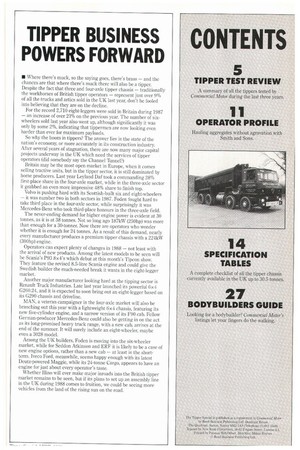TIPPER BUSINESS POWERS FORWARD
Page 53

If you've noticed an error in this article please click here to report it so we can fix it.
• Where there's muck, so the saying goes, there's brass — and the chances are that where there's muck there will also be a tipper. Despite the fact that three and four-axle tipper chassis — traditionally the workhorses of British tipper operators — represent just over 9% of all the trucks and artics sold in the UK last year, don't be fooled into believing that they are on the decline.
For the record 2,710 eight-leggers were sold in Britain during 1987 — an increase of over 21% on the previous year. The number of sixwheelers sold last year also went up, although significantly it was only by some 2%, indicating that tippermen are now looking even harder than ever for maximum payloads.
So why the boom in tippers? The answer lies in the state of the nation's economy, or more accurately in its construction industry. After several years of stagnation, there are now many major capital projects underway in the UK which need the services of tipper operators (did somebody say the Channel Tunnel?) Britain may be the most open market in Europe, when it comes selling tractive units, but in the tipper sector, it is still dominated by home producers. Last year Leyland Daf took a commanding 28% first-place share in the four-axle market, while in the three-axle sector it grabbed an even more impressive 48% share to finish top.
Volvo is pushing hard with its Scottish-built six and eight-wheelers — it was number two in both sectors in 1987. Foden fought hard to take third place in the four-axle sector, while surprisingly it was Mercedes-Benz who took third-place honours in the three-axle field.
The never-ending demand for higher engine power is evident at 30 tonnes, as it is at 38 tonnes. Not so long ago 187kW (250hp) was more than enough for a 30-tonner. Now there are operators who wonder whether it is enough for 24 tonnes. As a result of this demand, nearly every manufacturer produces a premium tipper chassis with a 224kW (300hp) engine.
Operators can expect plenty of changes in 1988 — not least with the arrival of new products. Among the latest models to be seen will be Scania's P93 8x4's which debut at this month's Tipcon show. They feature the revised 8.5-litre Scania engine and could give the Swedish builder the much-needed break it wants in the eight-legger market.
Another major manufacturer looking hard at the tipping sector is Renault Truck Industries. Late last year launched its powerful 6x4 G260.24, and it is expected to soon bring out an eight-legger based on its G290 chassis and driveline.
MAN, a veteran campaigner in the four-axle market will also be branching out this year with a lightweight 6x4 chassis, featuring its new five-cylinder engine, and a narrow version of its F90 cab. Fellow German-producer Mercedes-Benz could also be getting in on the act as its long-promised heavy truck range, with a new cab, arrives at the end of the summer. It will surely include an eight-wheeler, maybe even a 3028 model_ Among the UK builders, Foden is moving into the six-wheeler market, while for Seddon Atkinson and ERF it is likely to be a case of new engine options, rather than a new cab — at least in the shortterm. Iveco Ford, meanwhile, seems happy enough with its latest Deutz-powered Maggie, while its 24-tonne Cargo, appears to have an engine for just about every operator's taste.
Whether Hino will ever make major inroads into the British tipper market remains to be seen, but if its plans to set up an assembly line in the UK during 1988 comes to fruition, we could be seeing more vehicles from the land of the rising sun on the road.




































































































































